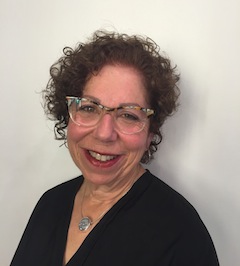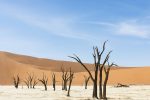A photograph of Deadvlei in Namibia, by Judi Angel, is part of the exhibit Eye Lines, at Zack Gallery until April 30.
Five years ago at Zack Gallery, Judi Angel had a solo show of photographs from her time as a volunteer in Asia and Africa. Most of her work from that period was portraits of people she met during her travels. By contrast, her new solo exhibit, also the product of her travels, features no people – instead, her latest works transform landscapes into geometry, into lines, colours and shapes. The title of the new Zack show, Eye Lines, reflects the artist’s new approach.
“Each photo in this show has a leading line,” Angel said in an interview with the Jewish Independent. “That line attracts the viewer’s gaze, builds a narrative. It takes your imagination on a journey. You look at the image and you ask questions. Where are we? Where are we going? How do we get there? What is beyond the frame?”
Her fascination with lines started in recent years. “I took a photography class on developing your own style,” she said. “I hadn’t noticed how much I use lines in my images until I went back over my photos, thousands of them. Then the lines emerged as something important, so I decided to exploit that direction and enjoy what comes of it.”
She doesn’t consider herself a professional photographer, despite the artistic quality of her photos. “Photography is a serious hobby for me. I’m not trying to make a living with it,” she said. “I want it to be fun and challenging. I’m looking for new ways to express my vision of the world.”

Awhile ago, she began experimenting with her craft. Layering, double exposure, conceptual photography and a new medium for her images – sublimation printing on aluminum – are only some of the new things she has played with recently. But finding unusual images and original angles are still her primary goals.
“Five years ago, when my husband and I volunteered in impoverished countries, my photos were like a documentary. Now, I want to experiment more,” she said. “We still travel, but the trips are shorter. We don’t want to leave home for long periods of time; we have eight grandchildren. But we often travel specifically to places I want to photograph, like Africa – it is a visual feast for a photographer.”
Earlier this year, she and her husband traveled to Namibia. “We went there particularly for photography,” she explained. A few photos in the exhibit come from one of the major Namibian tourist attractions, a ghost town, called Kolmanskop, in the Namib Desert. According to Angel, Kolmanskop was a mining town founded in the earlier 1900s by German settlers to mine diamonds. The miners built their town in their homeland’s style.
“It had all the amenities: a hospital, a casino, a school, even a ballroom,” she said. “Unfortunately, by the middle of the 20th century, the mine’s diamond production petered out and the town was abandoned.”
Today, only sand and tourists move among the empty buildings, and Angel’s photographs demonstrate the power of both. The desert irrevocably reclaims its own, encroaching on the former human dwellings, creeping in through broken windows and open doors. The rippling sand dunes inside the houses look eerie, almost alien beneath the pastel-coloured walls.
A different alien landscape meets the travelers outside, in the desert. Angel’s photos of the desert reflect the stark contrast of blue sky and yellow sand. The colours are blinding. “There is a new railway there, in the desert, but the sand always moves. It covers the rails every day and has to be constantly cleared,” she said. Her photograph of a sand dune a couple of metres high, piling across the straight line of rails, is awe-inspiring and achingly beautiful.
Another unique desert photograph sports three colours instead of two. A grove of dead trees stretch their long-dry branches upward, adding dark brown to the blue-and-yellow combination of the desert. “The trees have been there for 600 years,” said Angel. “The dryness of the desert preserves the wood from rotting and crumbling, so they just stand there.”
Most other pictures in the exhibit reveal architectural elements, as seen through the artist’s lens. Several of them are in the monochrome palette, while all the desert pictures use colour. “I like colour, especially the warm yellows, reds and blues, but sometimes, black-and-white is the only option,” she explained. “In my geometrical photos, black-and-white emphasize lines, while colours would be distracting.”
Her architectural photos are not precise copies of real life but rather an enhanced fantasy, a capriccio on an urban theme. One of her favourite image-manipulation programs is Photoshop. “Some photographers say that using Photoshop means cheating, but I don’t think so,” she said. “Photoshop is my tool, like paintbrushes for an artist. It has so many creative possibilities, and I experiment with them.”
Angel’s experimentations led her to join the Capture Photography Festival, and the current show at the Zack is part of the festival. Launched in 2013, this year’s festival presents photography at more than 70 galleries and community spaces throughout Vancouver.
“I like visiting their shows – so many outstanding artists,” said Angel, noting, “They have judges to ensure that every participating photographer and every exhibition are on a decent level.”
Eye Lines opened at the Zack on March 30 and will continue until April 30. To learn more about Angel’s work, visit judiangel.com.
Olga Livshin is a Vancouver freelance writer. She can be reached at olgagodim@gmail.com.

